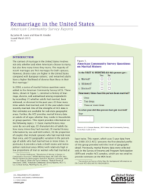Remarriage in the United States
Remarriage in the United States
Introduction
The context of marriage in the United States involves not only whether and when Americans choose to marry, but also how many times they marry. The majority of recent marriages are first marriages for both spouses. However, divorce rates are higher in the United States compared with European nations,1 and remarried adults have a higher likelihood of divorce than those in their first marriage.2
In 2008, a series of marital history questions were added to the American Community Survey (ACS). These items, shown in Figure 1, construct a history of marriage, divorce, and widowhood among respondents by recording: (1) whether adults had married, been widowed, or divorced in the past year; (2) how many times adults had married; and (3) the year adults most recently married. One of the strengths of ACS data is that estimates are available for sub-state geographic areas. Further, the ACS provides marital history data on adults of all ages whether they reside in households or group quarters. This report provides information on the following topics: (1) basic marital history measures by sex and age, (2) characteristics of adults by how many times they had married, (3) marital history information by sex and birth cohort, (4) the proportion of couples that include spouses who had married more than once, and (5) geographic variation in the percentage of adults who had married two or more times. In particular, it provides a look at both states and metropolitan statistical areas (MSAs) with relatively high or low proportions of men or women who had married at least twice. This report, which uses 5-year data from the 2008–2012 ACS,3 presents the first detailed profile of this group provided with this level of geographic detail. Previously, marital history data were collected only in the Survey of Income and Program Participation (SIPP) and smaller ACS samples, which are too small to provide estimates at the MSA level.
Some highlights of the report are:
- About half of all men (50 percent) and women (54 percent) aged 15 and over had married only once.
- The proportion of adults that had married only once has decreased since 1996, from 54 percent to 50 percent of men and 60 percent to 54 percent of women.
- Between 1996 and 2008–2012, the share of those that had married twice or three or more times increased only for women aged 50 and older and men aged 60 and older.
- Non-Hispanic White men and women are most likely to have married three or more times, while Asian men and women are least likely.4
- Those with at least a bachelor’s degree are more likely to have married only once (64 percent) than all adults (52 percent).
- The majority of recent marriages (58 percent) are first marriages for both spouses, although 21 percent involve both spouses marrying for at least the second time.
- States with a lower share of evermarried adults who had remarried are concentrated in the Northeast and Midwest, while Southern and Western states generally have a higher share.
- Lake Havasu City-Kingman, Arizona and Prescott, Arizona are among the MSAs with the highest percentage of evermarried adults who had remarried, with about 40 percent or more.
__________
1 See Gunnar Andersson, “Dissolution of Unions in Europe: A Comparative Overview,” MPIDR Working Paper, WP 2003-004, Max Planck Institute for Demographic Research, Rostock, Germany, 2003.
2 See Diana B. Elliott and Tavia Simmons, “Marital Events of Americans: 2009,” American Community Survey Reports, ACS-13, U.S. Census Bureau, Washington, DC, 2011.
3 See section on Source of the Data for background information on the 5-year ACS data and its interpretation.
4 Individuals who responded to the question on race by indicating only one race are referred to as the race-alone population or the group that reported only one race category. This report will refer to the White-alone population as White, the Black-alone population as Black, the Asian-alone population as Asian, and the White-alone, non-Hispanic population as non-Hispanic White unless otherwise noted.
Tables
Others in Series
Publication
Publication
Publication





